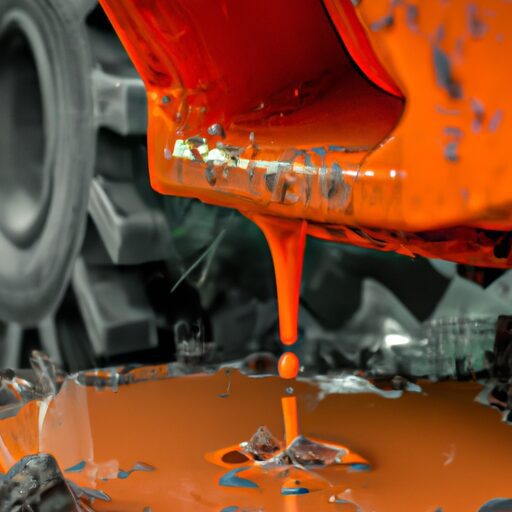Does Hydraulic Fluid Cause Cancer
Hydraulic fluids are widely used in various industries for their ability to transmit power and lubricate machinery. However, concerns have been raised regarding the potential health risks associated with these fluids. This article aims to examine whether hydraulic fluid can cause cancer by analyzing its composition and exploring relevant research studies.
One statistic that highlights the significance of this issue is the large number of workers exposed to hydraulic fluids on a daily basis. According to the Occupational Safety and Health Administration (OSHA), approximately 2 million workers in the United States alone are potentially exposed to these fluids in their workplaces. Given this widespread exposure, it becomes crucial to evaluate the potential carcinogenic components present in hydraulic fluids and understand their impact on human health.
By providing an objective and evidence-based analysis of existing scientific literature, this article intends to shed light on the potential cancer-causing properties of hydraulic fluid. Furthermore, it will explore workplace safety measures, regulations, industry practices, and alternatives available to mitigate any possible risks associated with these fluids.
Understanding Hydraulic Fluids
Hydraulic fluids are a diverse group of substances with varying chemical compositions and properties that are specifically designed to transmit power in hydraulic systems. Understanding hydraulic systems and the importance of hydraulic fluid is crucial for their efficient operation.
Hydraulic systems use fluid to generate, control, and transmit power. They are commonly found in various industries such as construction, aerospace, and automotive. Hydraulic fluids play a vital role in this process by transferring energy from one component to another within the system. They provide lubrication, reduce friction, prevent corrosion, and cool down the system by dissipating heat.
The choice of hydraulic fluid depends on several factors including system design, operating conditions, temperature range, pressure requirements, and compatibility with system components. Different types of hydraulic fluids include mineral oil-based fluids, synthetic esters, water-glycol mixtures, and phosphate esters.
Understanding the properties and characteristics of each type is essential for selecting the appropriate fluid for specific applications. For example, mineral oil-based fluids offer good lubricity but have limited fire resistance compared to synthetic esters or water-glycol mixtures.
Examining the potential health risks associated with hydraulic fluid will provide further insights into its impact on human well-being.
Examining the Potential Health Risks
Scientific studies have been conducted to investigate the potential link between hydraulic fluids and cancer. These studies aim to provide evidence-based information on the health risks associated with exposure to hydraulic fluids. Additionally, expert opinions from researchers and industry guidelines play a crucial role in understanding and assessing these risks objectively and thoroughly.
Scientific Studies on the Link Between Hydraulic Fluids and Cancer
Numerous studies have examined the potential association between hydraulic fluid exposure and cancer, with one study reporting that occupational exposure to hydraulic fluids was linked to a 20% increased risk of developing certain types of cancer. This suggests that there may be a possible link between hydraulic fluid exposure and the development of cancer. To gain a better understanding of this association, it is important to consider potential prevention methods and the long-term effects of hydraulic fluid exposure on human health.
To shed light on this topic, here are four key points to consider:
- Mechanisms: Researchers have investigated the mechanisms by which hydraulic fluids may contribute to carcinogenesis.
- Animal Studies: Animal studies have provided insights into the potential carcinogenic effects of hydraulic fluids.
- Human Studies: Epidemiological studies have explored the relationship between occupational exposure to hydraulic fluids and cancer incidence in humans.
- Limitations: It is crucial to acknowledge the limitations in these studies, such as confounding factors and potential biases.
Understanding these scientific findings can help inform expert opinions and industry guidelines regarding hydraulic fluid exposure and its potential impact on cancer development without implying causation or suggesting specific preventive measures should be taken at this stage.
Expert Opinions and Industry Guidelines
Expert opinions and industry guidelines provide valuable insights into the potential implications of hydraulic fluid exposure on human health and can help inform decision-making processes in various industries. According to experts, prolonged or repeated contact with hydraulic fluids may pose health risks due to the presence of harmful chemicals such as polycyclic aromatic hydrocarbons (PAHs) and heavy metals. The American Conference of Governmental Industrial Hygienists (ACGIH) has established occupational exposure limits for certain components found in hydraulic fluids, including particulate matter and specific PAHs. These guidelines aim to protect workers from potential adverse effects associated with long-term exposure. Furthermore, industry standards, such as those developed by the International Organization for Standardization (ISO), outline best practices for handling and managing hydraulic fluid to minimize health risks. By following these expert opinions and industry guidelines, organizations can effectively mitigate potential hazards associated with hydraulic fluid exposure.
Transitioning into the subsequent section about ‘carcinogenic components in hydraulic fluids’, it is essential to explore the specific substances that contribute to their potentially carcinogenic properties.
Carcinogenic Components in Hydraulic Fluids
This discussion will focus on the presence of harmful chemicals in certain hydraulic fluids, as well as the potential routes of exposure and associated risks. Some hydraulic fluids may contain carcinogenic components, which can pose a threat to human health. It is important to understand the various ways in which individuals can come into contact with these chemicals, such as through inhalation, skin contact, or ingestion. By examining the specific chemicals present in hydraulic fluids and their potential health effects, we can gain a better understanding of the risks involved and take appropriate measures to minimize exposure.
Harmful Chemicals Found in Some Hydraulic Fluids
Harmful chemicals have been detected in certain hydraulic fluids, raising concerns about their potential health risks. These hazardous ingredients can pose long-term effects on human health and the environment. It is important to understand the composition of hydraulic fluids and the potential risks they may present.
| Chemical | Potential Health Effects |
|---|---|
| Lead | Neurological damage, developmental delays |
| Chromium | Lung cancer, respiratory issues |
| Benzene | Leukemia, reproductive disorders |
| Formaldehyde | Nasal and throat irritation, cancer |
These are just a few examples of harmful chemicals that have been found in some hydraulic fluids. The presence of these substances highlights the need for proper handling and disposal procedures to protect both workers and the environment from potential exposure. In the subsequent section about potential exposure routes and risks, we will explore how these chemicals can be encountered and their associated dangers.
Potential Exposure Routes and Risks
One must be aware of the potential exposure routes and associated risks related to the presence of harmful chemicals in hydraulic fluids. Exposure to these chemicals can occur through various routes, including inhalation, dermal contact, and ingestion. Inhalation is a common route of exposure when individuals breathe in contaminated air or vapors during hydraulic fluid use. Dermal contact can occur when skin comes into direct contact with hydraulic fluid or surfaces contaminated with it. Ingestion may occur if individuals accidentally swallow hydraulic fluid or fail to wash their hands before eating or drinking after handling it. These exposure routes pose health risks that include respiratory irritation, skin irritation or sensitization, gastrointestinal effects, and potential long-term health effects such as cancer. To mitigate these risks and ensure workplace safety, proper ventilation systems, personal protective equipment (PPE), and hygiene practices should be implemented.
Transitioning into the subsequent section regarding workplace safety measures: It is crucial for organizations to implement appropriate measures to protect workers from potential hazards associated with hydraulic fluids.
Workplace Safety Measures
To ensure the safety of workers, it is imperative to establish and enforce proper workplace safety measures in relation to hydraulic fluid usage. Workplace accidents involving hydraulic fluids can have serious consequences, including injuries such as burns, dermatitis, and eye damage. Therefore, implementing appropriate safety protocols is crucial.
One key measure is providing workers with personal protective equipment (PPE) that includes gloves, goggles, and protective clothing. This helps minimize direct contact with hydraulic fluid and reduces the risk of skin irritation or chemical burns. Additionally, regular training programs should be conducted to educate employees on safe handling practices and emergency procedures.
Another important aspect of workplace safety is maintaining a clean working environment. Spills or leaks should be promptly cleaned up to prevent slips and falls. Adequate ventilation systems are also essential to minimize exposure to airborne contaminants that may be present during hydraulic fluid use.
Furthermore, employers should regularly inspect machinery for any leaks or malfunctions that could result in potential hazards. Establishing clear communication channels between workers and management can help identify potential issues early on and address them promptly.
In conclusion, implementing proper workplace safety measures is essential for protecting employees from the potential risks associated with hydraulic fluid usage. By adopting these precautions, companies can create a safer work environment for their employees while reducing the occurrence of workplace accidents related to hydraulic fluid handling. Transitioning into the subsequent section about ‘regulations and standards,’ it is important to consider how these measures align with existing industry guidelines for enhanced workplace safety without compromising efficiency or productivity.
Regulations and Standards
Implementing regulations and standards in the workplace creates a sturdy framework, akin to a well-constructed bridge, ensuring the safety of workers handling hydraulic fluids. These regulations are enforced by regulatory agencies at both national and international levels to maintain uniformity and consistency in workplace safety practices. Compliance with these standards helps protect workers from potential hazards associated with hydraulic fluids and reduces the risk of cancer or other adverse health effects.
To grab the attention of the audience, here are three key components of regulation enforcement and international standards related to hydraulic fluid safety:
-
Hazard Communication: Regulations require employers to provide comprehensive information about the potential hazards of hydraulic fluids, including carcinogenic properties, through Safety Data Sheets (SDS). This ensures that workers are aware of the risks involved and can take appropriate precautions.
-
Personal Protective Equipment (PPE): Standards specify the use of protective clothing, gloves, goggles, and respiratory equipment when working with hydraulic fluids. Employers must ensure that PPE is readily available for workers and regularly maintained to provide effective protection.
-
Training Programs: Regulations mandate training programs for employees who handle hydraulic fluids. These programs aim to educate workers about safe handling practices, proper use of PPE, emergency response procedures, and spill containment measures.
Incorporating these regulations into workplace practices safeguards workers from potential health risks associated with hydraulic fluid exposure. Transitioning into the subsequent section on industry practices and alternatives reveals further steps taken by organizations to enhance worker safety without compromising efficiency or productivity.
Industry Practices and Alternatives
Industry practices and alternatives play a crucial role in enhancing worker safety and minimizing potential health risks associated with the handling of hydraulic fluids. Given the concerns regarding the possible carcinogenic effects of hydraulic fluids, industries have been adopting various alternative solutions to mitigate these health implications.
One common approach is to use less toxic hydraulic fluids that have lower health risks. For instance, vegetable-based oils or synthetic esters can be used as an alternative to conventional petroleum-based hydraulic fluids. These alternatives offer similar performance characteristics while reducing the exposure to potentially harmful substances.
Furthermore, industry practices focus on implementing preventive measures such as proper training programs for workers, effective ventilation systems, and regular maintenance of hydraulic systems. Adequate personal protective equipment (PPE) is also provided to minimize direct contact with hydraulic fluids.
In addition, industries are increasingly embracing advanced technologies that reduce the need for human interaction with hydraulic systems. Automation and remote monitoring systems help minimize worker exposure to hydraulic fluid hazards.
Overall, by incorporating alternative solutions and implementing best practices, industries can effectively reduce the health implications associated with hydraulic fluid handling. In the next section about ‘conclusion and recommendations,’ we will discuss further steps that can be taken to ensure worker safety in this context.
Conclusion and Recommendations
In conclusion, the findings of this study have shed light on the potential risks associated with hydraulic fluid and its possible link to cancer. Although further research is needed to establish a definitive causal relationship, it is recommended that precautionary measures be taken when handling hydraulic fluids. Guidelines for safe use and handling should include wearing appropriate personal protective equipment, ensuring proper ventilation in work areas, and implementing regular monitoring and maintenance of hydraulic systems to minimize exposure to potentially harmful substances.
Summary of Findings
Conclusively examining the research findings, it becomes evident that there is no concrete evidence linking hydraulic fluid to causing cancer. Numerous studies have been conducted to investigate the potential health effects of hydraulic fluid exposure, and while some studies suggest a possible association between certain components of hydraulic fluids and adverse health outcomes, the overall evidence is inconclusive. Risk assessments conducted by regulatory agencies have also failed to establish a definitive link between hydraulic fluid and cancer. It is important to note that these findings are based on current scientific knowledge and may be subject to change as new research emerges. Moving forward, guidelines for safe use and handling of hydraulic fluids should be followed to minimize any potential risks associated with exposure.
Guidelines for Safe Use and Handling of Hydraulic Fluids
In light of the previous subtopic discussing the summary of findings regarding hydraulic fluid and its potential link to cancer, it is important to establish guidelines for safe use and handling of this substance. Safe handling practices are crucial in minimizing the risk associated with hydraulic fluids. It is recommended to wear appropriate protective equipment, such as gloves and goggles, when working with or around hydraulic fluid. Additionally, it is essential to follow proper storage procedures to prevent leakage or spills. Regular maintenance checks should be conducted on hydraulic systems to ensure their integrity and identify any potential issues that may arise. By adhering to these guidelines, individuals can mitigate the risks associated with hydraulic fluid and promote a safer working environment.
Frequently Asked Questions
Can hydraulic fluid directly cause cancer in humans?
Hydraulic fluid does not directly cause cancer in humans. However, exposure to certain chemicals found in hydraulic fluids can increase the risk of developing cancer. Implementing proper safety measures and using protective equipment can help prevent this risk.
What are the most common symptoms or health effects associated with exposure to hydraulic fluid?
Exposure to hydraulic fluid can lead to various health effects, including skin irritation, respiratory issues, and eye damage. Potential long-term effects may include organ damage and neurological disorders. Preventative measures such as wearing protective gear are recommended.
Are there specific industries or occupations that are at a higher risk of exposure to carcinogenic components in hydraulic fluids?
Industries and occupations that involve working with hydraulic fluids, such as automotive repair, aviation maintenance, and manufacturing, may be at a higher risk of exposure to carcinogenic components present in these fluids. This is due to the potential inhalation or skin contact with the harmful substances.
Are there any long-term studies or research conducted on the health effects of hydraulic fluid exposure?
Long-term research studies have been conducted to examine the health effects of exposure to hydraulic fluid. These studies provide evidence-based information on various health outcomes associated with prolonged exposure to hydraulic fluids, allowing for a comprehensive understanding of the potential risks involved.
What are some effective workplace safety measures to minimize the risk of exposure to hydraulic fluid and its potential carcinogenic components?
Workplace safety regulations should be implemented to minimize the risk of exposure to hydraulic fluid and its potential carcinogenic components. This includes providing appropriate protective equipment and ensuring compliance with safety procedures.
Conclusion
In conclusion, hydraulic fluids have been found to contain potentially carcinogenic components, posing a health risk to those exposed to them. Workplace safety measures and adherence to regulations and standards are crucial in minimizing exposure and protecting workers. The industry should consider exploring alternatives that are safer for human health while maintaining efficient hydraulic systems. It is imperative for companies to prioritize the well-being of their employees by implementing comprehensive safety protocols and promoting the use of less hazardous hydraulic fluid options. By doing so, they can mitigate the potential risks associated with these substances.







